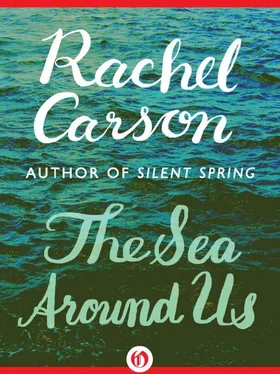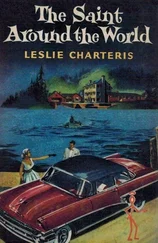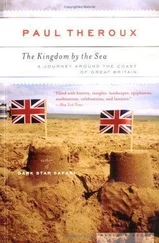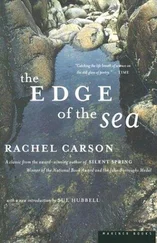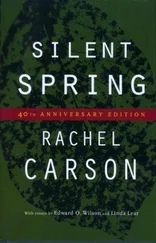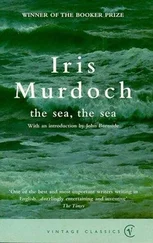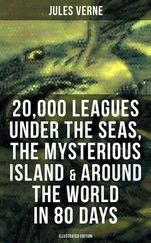Another group of organisms, lacking the chlorophyll but needing organic food, found they could make a way of life for themselves by devouring the plants. So the first animals arose, and from that day to this, every animal in the world has followed the habit it learned in the ancient seas and depends, directly or through complex food chains, on the plants for food and life.
As the years passed, and the centuries, and the millions of years, the stream of life grew more and more complex. From simple, one-celled creatures, others that were aggregations of specialized cells arose, and then creatures with organs for feeding, digesting, breathing, reproducing. Sponges grew on the rocky bottom of the sea’s edge and coral animals built their habitations in warm, clear waters. Jellyfish swam and drifted in the sea. Worms evolved, and starfish, and hard-shelled creatures with many-jointed legs, the arthropods. The plants, too, progressed, from the microscopic algae to branched and curiously fruiting seaweeds that swayed with the tides and were plucked from the coastal rocks by the surf and cast adrift.
During all this time the continents had no life. There was little to induce living things to come ashore, forsaking their all-providing, all-embracing mother sea. The lands must have been bleak and hostile beyond the power of words to describe. Imagine a whole continent of naked rock, across which no covering mantle of green had been drawn—a continent without soil, for there were no land plants to aid in its formation and bind it to the rocks with their roots. Imagine a land of stone, a silent land, except for the sound of the rains and winds that swept across it. For there was no living voice, and no living thing moved over the surface of the rocks.
Meanwhile, the gradual cooling of the planet, which had first given the earth its hard granite crust, was progressing into its deeper layers; and as the interior slowly cooled and contracted, it drew away from the outer shell. This shell, accommodating itself to the shrinking sphere within it, fell into folds and wrinkles—the earth’s first mountain ranges.
Geologists tell us that there must have been at least two periods of mountain building (often called “revolutions”) in that dim period, so long ago that the rocks have no record of it, so long ago that the mountains themselves have long since been worn away. Then there came a third great period of upheaval and readjustment of the earth’s crust, about a billion years ago, but of all its majestic mountains the only reminders today are the Laurentian hills of eastern Canada, and a great shield of granite over the flat country around Hudson Bay.
The epochs of mountain building only served to speed up the processes of erosion by which the continents were worn down and their crumbling rock and contained minerals returned to the sea. The uplifted masses of the mountains were prey to the bitter cold of the upper atmosphere and under the attacks of frost and snow and ice the rocks cracked and crumbled away. The rains beat with greater violence upon the slopes of the hills and carried away the substance of the mountains in torrential streams. There was still no plant covering to modify and resist the power of the rains.
And in the sea, life continued to evolve. The earliest forms have left no fossils by which we can identify them. Probably they were soft-bodied, with no hard parts that could be preserved. Then, too, the rock layers formed in those early days have since been so altered by enormous heat and pressure, under the foldings of the earth’s crust, that any fossils they might have contained would have been destroyed.
For the past 500 million years, however, the rocks have preserved the fossil record. By the dawn of the Cambrian period, when the history of living things was first inscribed on rock pages, life in the sea had progressed so far that all the main groups of back-boneless or invertebrate animals had been developed. But there were no animals with backbones, no insects or spiders, and still no plant or animal had been evolved that was capable of venturing onto the forbidding land. So for more than three-fourths of geologic time the continents were desolate and uninhabited, while the sea prepared the life that was later to invade them and make them habitable. Meanwhile, with violent tremblings of the earth and with the fire and smoke of roaring volcanoes, mountains rose and wore away, glaciers moved to and fro over the earth, and the sea crept over the continents and again receded.

It was not until Silurian time, some 350 million years ago, that the first pioneer of land life crept out on the shore. It was an arthropod, one of the great tribe that later produced crabs and lobsters and insects. It must have been something like a modern scorpion, but, unlike some of its descendants, it never wholly severed the ties that united it to the sea. It lived a strange life, half-terrestrial, half-aquatic, something like that of the ghost crabs that speed along the beaches today, now and then dashing into the surf to moisten their gills.
Fish, tapered of body and stream-molded by the press of running waters, were evolving in Silurian rivers. In times of drought, in the drying pools and lagoons, the shortage of oxygen forced them to develop swim bladders for the storage of air. One form that possessed an air-breathing lung was able to survive the dry periods by burying itself in mud, leaving a passage to the surface through which it breathed.
It is very doubtful that the animals alone would have succeeded in colonizing the land, for only the plants had the power to bring about the first amelioration of its harsh conditions. They helped make soil of the crumbling rocks, they held back the soil from the rains that would have swept it away, and little by little they softened and subdued the bare rock, the lifeless desert. We know very little about the first land plants, but they must have been closely related to some of the larger seaweeds that had learned to live in the coastal shallows, developing strengthened stems and grasping, rootlike holdfasts to resist the drag and pull of the waves. Perhaps it was in some coastal lowlands, periodically drained and flooded, that some such plants found it possible to survive, though separated from the sea. This also seems to have taken place in the Silurian period.
The mountains that had been thrown up by the Laurentian revolution gradually wore away, and as the sediments were washed from their summits and deposited on the lowlands, great areas of the continents sank under the land. The seas crept out of their basins and spread over the lands. Life fared well and was exceedingly abundant in those shallow, sunlit seas. But with the later retreat of the ocean water into the deeper basins, many creatures must have been left stranded in shallow, landlocked bays. Some of these animals found means to survive on land. The lakes, the shores of the rivers, and the coastal swamps of those days were the testing grounds in which plants and animals either became adapted to the new conditions or perished.
As the lands rose and the seas receded, a strange fishlike creature emerged on the land, and over the thousands of years its fins became legs, and instead of gills it developed lungs. In the Devonian sandstone this first amphibian left its footprint.
On land and sea the stream of life poured on. New forms evolved; some old ones declined and disappeared. On land the mosses and the ferns and the seed plants developed. The reptiles for a time dominated the earth, gigantic, grotesque, and terrifying. Birds learned to live and move in the ocean of air. The first small mammals lurked inconspicuously in hidden crannies of the earth as though in fear of the reptiles.
Читать дальше
